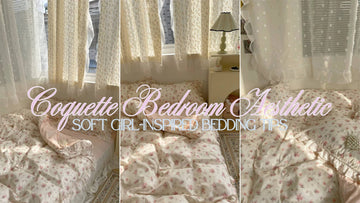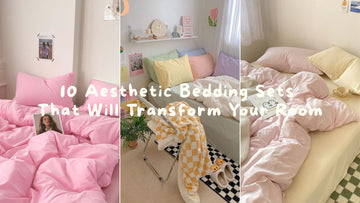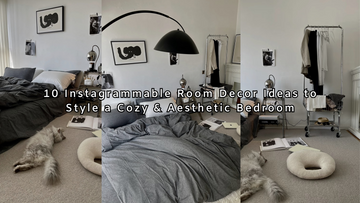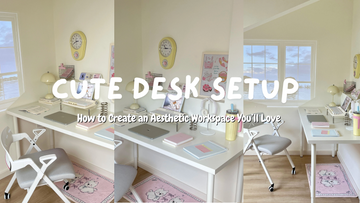Dopamine decor has taken the interior design world by storm in recent years. This mood-boosting trend is all about filling your home with vibrant colour palettes, playful textures and decor that brings joy.
Dopamine decor advocates tend to steer clear of the concept of conservative or minimalist home design, instead going for a more maximalist aesthetic, layering their homes with a diverse collection of embellishments that spark happiness, thus creating a space that authentically reflects their personalities.
What Are the Benefits of Dopamine Decor?
Understanding Dopamine and Its Role
Dopamine is a neural transmitter responsible for allowing us to experience feelings of pleasure, satisfaction and motivation - it's often called the "happy hormone". There is research that suggests our environment, which encompasses our home and its interior design, has a direct impact on our mood. Dopamine decor champions design their homes with this in mind, crafting them into a source of vibrancy and happiness.
How to Decorate for Dopamine
This trend suggests that embracing an energetic and dynamic style and indulging in eccentric decorations satisfies the need for things that make you happy, stimulating a dopamine release. The goal is to bring a personalised, mood-boosting quality to every area of your home.
Some designers find inspiration by reminiscing about their childhood bedrooms, where happiness was the guiding principle of interior design. Think back to your youth - how did you want your room to look? Full of colour? Walls adorned with posters of your favourite bands or celebrities? By tapping into a playful sense of style, you can increase the positivity your home provides, elevating your mood and subsequently benefitting areas of your life like productivity and sleep.
So let's dive in and look at seven ways you can decorate for dopamine!
1: Enhancing Mood with Dopamine-Drenched Colour Schemes

The dopamine decor trend places a lot of emphasis on the colour. Studies have found that different colours can trigger dopamine release in the brain. Vibrant shades such as red, orange and yellow are particularly stimulating, increasing the dopamine release, perhaps because of their associations with positivity, grounding and warmth.
When you search for dopamine decor inspiration online, you're likely to find an abundance of pink, yellow, sky blue and mint green, but how you decorate your space should always be determined by your preference and which colours make you happy.
With that said, here are a few of my favourite dopamine decor colour palettes to give you some ideas!

Lavender Fairytale: Dreamy and Feminine

Melon Salad: Fresh and Sweet


2: Enhancing Tactile Satisfaction with Comforting Textures
Dopamine decor may be particularly attractive to individuals diagnosed with ADHD as they can have issues regulating their levels of this "feel-good" hormone. Dopamine can be released in response to tactile stimuli, and some ADHDers are more sensitive to sensory input. Tactilely pleasing home decor can potentially stimulate dopamine, thus providing relief from anxiety, depression and stress (emotions that people with ADHD may have extra difficulty regulating).
While dopamine decor may be alluring to those with ADHD, neurotypicals can also benefit! If you want to create a space that is dopamine-friendly, you might consider incorporating some of the following items in your home:
Textured Surfaces:

Have you ever wanted to reach out and touch a velvet armchair or embossed wallpaper just because you know it will feel amazing? Providing tactile interest in the form of textured surfaces is a great way to add to your dopamine decor. Outside of the obvious choices for intriguing textures like wallpaper and soft furnishings, things like textured artwork, velvet curtains or even woven, knitted or crocheted fabrics can have a remarkable effect.
Squishy Rugs or Carpets:

There's nothing better than feeling your bare feet sink into a heavenly soft rug! I have a squashy, high-pile rug next to my bed. It's the first thing my feet touch when I get up in the morning, providing instant comfort in the early hours.
Blankets and Pillows:

Add to the comfort factor of your space by filling it with plush items like soft, cosy throw pillows or fleece blankets. Research suggests that weighted blankets, in particular, can decrease anxiety and increase serotonin and dopamine as they may cause the same response in your body as when you receive a hug.
3: Get Playful with Unique Furniture and Decorations

Aiming to inject energy and fun into our designs, dopamine decor promotes using bright colours, funky patterns and unique furniture and artwork. Stepping outside the norm is at the heart of this style, so here are some ideas to inspire your extraordinary decor!
Quirky Decor:

Abstract decor encompasses everything quirky or out of the ordinary, especially unconventional shapes, patterns and themes that provide visual interest. These seamlessly integrate with the bright colours that are so prominent in the dopamine decorating game.
4: Showcase Your Individuality by Adding Personal Touches
It's easy to get lost in the idea of a trend and feel you must match your design to those seen on social media or in a magazine, but remember that dopamine decor is supposed to make you happy. So copying and pasting someone else's interior design into your home may not have the desired effect if it doesn't match your unique style. Instead, unapologetically saturate your home with your personality.
Spark Happy Memories:

When we see something that we associate with a past positive experience, it can ignite that memory and bring back the emotions we felt at the time. Photographs from happy occasions, souvenirs from amazing vacations or even heirlooms that remind you of positive family values can all spark joy.
Reflect Your Passions:

Things you feel passionate about can help to bring joy to your home, even in unexpected ways. Artists might consider displaying their creations, or those who enjoy baking could find happiness in decorations that reflect their culinary love. As a book enthusiast, I have meticulously arranged my (ever-growing) book collection by the colour of the covers, creating an aesthetically pleasing rainbow effect. It was fun to do and looks delectably pleasing to the eye, making it a core element of my living room design.
5: Bring Nature Indoors to Elevate the Energy

Many studies suggest having fresh flowers and plants in your home can boost your mood. The optimistic colours of flowers and the freshening qualities of houseplants can have a significant effect. Similarly, natural materials in the home can provide an earthy, calming atmosphere.
Fresh Flowers:

If it's in your budget, consider bringing home a bouquet of fresh flowers each week. Research suggests that fresh flowers can help to reduce depression, anxiety and stress. They can also add brightness to your home if you opt for colourful flora combinations and vibrant shades.
Dried Flower Bouquets:

A downside of fresh flowers is that they don't last. Dried bouquets are a fantastic alternative. They can be a little more expensive but are worth the investment as they are long-lasting and just as beautiful as a fresh floral arrangement.
Houseplants:

Having houseplants in your home can provide all sorts of benefits, such as cleaner air and improved mood. Furthermore, caring for houseplants, such as watering or repotting, can positively impact your mental health.
Natural Materials:

Including natural materials such as wicker, wood, cotton, and bamboo is a great way to uplift your space and create an organic aesthetic.
6: Enhance the Atmosphere with Dopamine-Friendly Lighting

Lighting has an incredible ability to affect the atmosphere of a room. It's common knowledge that natural sunlight can boost mood and physical health. Therefore, it's important to prioritise good lighting in your dopamine decor design.
Optimise Natural Sunlight:

To allow as much natural light into your space as possible, keep your blinds open and avoid putting too much "bulk" around your windows.
Enhance Natural Lighting:

We don't always get a say in how much natural light comes into our home, but there are ways in which we can optimise this light, such as using mirrors to reflect light across the room and using light colours on our walls, such as white, to create a sense of brightness.
Ambient Lighting:

Creating sources of ambient lighting can help to create a cosy vibe in your home and improve your mood, especially in the colder months when we get less daylight. Relying on just an overhead light can create a clinical atmosphere, but layering your light sources creates a softer, warmer atmosphere, and you can achieve this with products like string lights, candles and small lamps.
7: Boost Your Mood with Scent
We've spoken about how tactile and visual sensory input impacts the quantity of dopamine produced in our brains, but our sense of smell can also affect our mood!
Aromatherapy:

Aromatherapy practitioners advocate for the use of essential oils. These come in an abundance of different scents for all sorts of purposes. Some studies suggest inhaling scents such as lavender or rosemary can boost mood. You can use essential oils in many different ways, such as in a diffuser or oil burner, or apply them to your skin (ensure they are safe to use topically).
Reed Diffusers:

Reed diffusers work by distributing scented oils through a reed which releases the scent into the room. These are great as they are long-lasting, low-maintenance and widely available in supermarkets and homeware stores. To increase the positive energy in your home, opt for uplifting aromas such as citrus or floral scents.
Room Sprays:

A benefit of room sprays is that you can control the amount of scent in the room, so if you have a sensitive nose, there's no need to overwhelm it! However, be meticulous in selecting room sprays and opt for ones with natural ingredients that are safe to inhale.
In a world of constantly rotating interior design trends, dopamine decor stands out as one that should stay in fashion! Cultivate your home so it's a source of happiness that nurtures your individuality.




